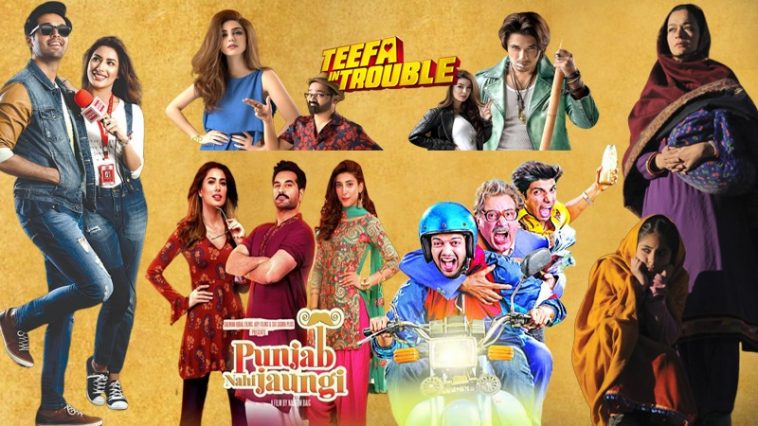Ever since “Waar” came out in 2013, the evolution of Pakistan’s film audience has been interesting to watch. Proven formulas of the past have fallen flat and new ones have emerged. What’s more, is that the Pakistani audience has shown itself to be uncompromising when it comes to technical standards.
Internet access and a more than decade long diet of Hindi and Hollywood cinema have exposed them to new standards of art direction, cinematography, special effects, action choreography and even more subtle shades of acting. While most can’t articulate exactly what all this maybe when it’s on screen, it’s unmistakable.
However, it’s not entertainers, romantic dramas, or patriotic films that seem to drive audiences, since both genres have seen their share of flops in Pakistan. It seems as if their overall vibe and finesse have played a bigger role in their success. And while the age old idiom, “There’s no accounting for taste”, still holds true, here’s a look at how the Pakistani Cinema audience has changed throughout the new wave.
2013-The Revival Begins with ‘Waar’
2013 was the year that Pakistani Cinema finally started up again. “Bol” and “Khuda Ka Liye” might had set the stage, but “Waar” was the firecracker that set the country ablaze. It was called the ‘Unstoppable Movie’. It cashed in on popular sentiment, patriotism, and the star power of Shaan Shahid to deliver more than 20 Cr at the local box office.
Its success was surrounded by the release of a few small films like “Zinda Bhaag” and of a few larger films like “Main Hoon Shahid Afridi”. The film’s main contribution however, was that it renewed hope in a film industry that had been lying dormant for decades.
2014-The Script is Flipped
After “Waar”, there seemed to be a flurry of news about the revival of cinema. New deals were being struck, new studios were being formed, and old ones reopened. However, 2014 was relatively quiet. A few films like “The System” and “Dukhtar” came and went, without making a mark…until Eid ul Azha.
Nabeel Qureshi’s “Na Maloom Afraad”, and Jami’s “Operation 021” competed for screens. However, while the latter, with a spy themed plot and Shaan in the lead role, seemed like the natural winner, “Na Maloom Afraad” obliterated it.
“Na Maloom Afraad” capitalized on the chaos that Karachi was known for, for a mostly original story. Fahad Mustafa, Javed Sheikh, and Mohsin Abbas Haider provided more than a few laughs and minted more than 14 Cr worldwide. In contrast, “Operation 021” was seen as a boring feature and made just shy of 6 Cr. It seemed like this time, patriotism and Shaan weren’t enough to set the screens on fire.
2015-Experimentation Galore
Many of the films released in 2015 had been in production for a while. However, their collective release made for perhaps the most experimental year for the new wave.
Humayun Saeed emerged as the new king of the Pakistani box office with “Jawani Phir Nahi Ani” and “Bin Roye”. Both films made big money at the local and foreign box office, with the former setting a record for the highest-grossing Pakistani film of all time.
What was most interesting to watch was Bin Roye’s success. It raked in approximately 12 Cr at the Pakistani box office, but a monumental 29.5 Cr total in overseas. Its overseas total has remained unbeaten for years. What “Bin Roye” showed above all else was that there was an appetite for local films at the foreign box office. This had been demonstrated by “Waar” which raked in 14 Cr at the foreign box office but not by any film since.
Other films like the comedies “Wrong No.” by Yasir Nawaz and “Karachi Se Lahore” by Wajahat Rauf, the crime caper “Jalaibee”, and the animated film “3 Bahadur” by Sharmeen Obaid Chinoy, all emerged as commercial successes. Even films like “Manto”, starring Sarmad Sultan Khoosat, and “Moor” by Jami were appreciated by audiences and critics alike.
Of course, there were flops here and there like the mediocre “Halla Gulla” and even the brilliant “Shah”, but the majority of films were succeeding. It seemed like Pakistani cinema was finally delivering on a range of topics and the audience was warming up to it. Or was it? Was this just a result of youthful optimism and exuberance? Would this carry on?
2016-From Strength to Strength
The Pakistani audience’s appetite didn’t seem to die down in 2016. While there weren’t any global chartbusters like Jawani Phir Nahi Ani, there were a lot of hits that established certain studios as big names in the industry.
The crown went to Nabeel Qureshi and Fizza Ali Meerza, for “Actor in Law”. The film minted 30 Cr and showed that Filmwala studios had clearly made a film that resonated with the masses. It also established Fahad Mustafa as a major actor in the industry. “Janaan”, produced by Imran Raza Kazmi, also followed this success with nearly 30 Cr in its kitty. The social drama that tackled the issue of child abuse resonated well with audiences.
“Ho Mann Jahaan”, the romantic drama that follows three friends through various trials and tribulations, starring Mahira Khan, Sheheryar Munawar, Adeel Hussain, and Sonya Jahan fared well at the box office as well. While these three films and a sequel to 3 Bahadur proved successful, films with critical acclaim such as “Mah-e-Mir” and “Dobara Phir Se” failed to connect with audiences and flopped.
While there was much less experimentation this year than before, it seemed like Pakistani cinema was gaining steam.
2017-Diminishing Returns
2017 brought with it a lot of disappointment. Highly anticipated films didn’t live up to their promise. The two most hotly anticipated films of the year were Shoaib Mansoor’s third film, “Verna”, and Hassan Waqas Rana’s “Yalghaar”. The former was the master’s return to the silver screen 6 years after the huge “Bol”, and the latter was the first film from the producer of Waar.
“Verna”, with its plot centered on rape, was seen by many critics as underdeveloped and half baked. The film didn’t generate a lot of numbers either, peaking at 9.35 Cr, worldwide. Despite a premise not fully explored in Pakistani cinema before, and objections raised by the censor board, the film was widely seen as unsuccessful.
“Yalghaar” however, was an even bigger letdown. It had been in production since Waar. It was supposed to be a retelling of the 2008 Swat Operation and was dedicated to the slain children of the 2014 APS Peshawar attack. It had been through several reshoots and was reportedly the most expensive film in the history of the country. Yet, it fizzled out after the first week. Hassan Waqas Rana proved to be a much less gifted director than Bilal Lashari.
Even more disappointing was Syed Noor and Shaan’s individual features. The former’s “Chain Aye Na” was mocked relentlessly as soon as its trailer was released. Shaan’s reimagining of Mahesh Bhatt’s classic, “Arth”, called “Arth-The Destination” was also a colossal failure. The two films failing could be seen as the Pakistani audience rejecting old Lollywood.
The rest of the year was peppered throughout with failure after failure. The two successes that emerged were Humayun Saeed’s “Punjab Nahi Jaungi” (51.65 Cr), and Nabeel Qureshi and Fizza Ali Meerza’s “Na Maloom Afraad 2” (21 Cr).
2018-Bouncing Back
This proved as the most successful year in the history of Pakistani cinema since the revival, with totals reaching 200 Cr. Humayun Saeed’s “Jawani Phir Nahi Ani 2” raked up 70 Cr worldwide, becoming the highest-grossing Pakistani film ever. Ali Zafar also threw his hat in to the ring with “Teefa in Trouble”. Though the film was mired in controversy due to sexual harassment allegations against him by Meesha Shafi, the film minted 50 Cr worldwide. Not only that, but it was recognized as a milestone in action choreography. The Hamza Ali Abbasi starrer, “Parwaz Hai Junoon”, based on the lives of Airforce pilots, minted 43 Cr worldwide.
However, the biggest surprise of the year was “The Donkey King”, an animated comedy from the creator of Commander Safeguard. It starred screen veteran Rambo as the titular character, along with other veterans like Ghulam Mohiuddeen, Hina Dilpazeer, and Javed Sheikh. The film, though apparently a harmless flick about a donkey becoming king of the jungle, hit cinemas right around the time that a new government was elected. This gave it a lot of political overtones, whether intentional or not. It ended up taking in 25 Cr. Other successes like Parchi (17 Cr), Load Wedding (13.5 Cr), and 7 Din Mohabbat In (13 Cr), kept cinema moving throughout the year.
While this year was a big success, it was clear that Pakistani filmmakers had settled into certain formulas like comedy and romance, which the public was responding to. Experiments like “Motorcycle Girl” (a film about motorcyclist Zenith Irfan) and “Allahyar and the Legend of Markhor” (animated film about animal poaching), failed to attract attention. The only exception was Cake (12 Cr), starring Aamina Sheikh and Sanam Saeed which was a surprise hit with the masses.
2019-Another Year of Disappointments
While some may disagree with this assessment, the numbers don’t lie. The highest grossing films of the year, “Superstar” and “Parey Hut Love” have failed to crack the 30 Cr barrier. Barely inching towards it, other films have either failed or fizzled out before reaching their full potential. While successes like “Wrong No. 2” (21.5 Cr), “Chhalawa” (18 Cr), “Sher Dil” (13 Cr), and “Heer Maan Ja” (11 Cr) have kept the ball rolling, cinemas have clearly suffered in 2019.
As far as experimental flicks go, directors did take chances. Shamoon Abbasi’s “Durj” and Kamal Khan’s “Laal Kaboor” both ventured in to unfamiliar territory. However, the former managed to win over much fewer hearts and mind than the latter. Most other films that tried to curve away from the norm like “Talaash”, “Ready Steady No”, and “Project Ghazi”, were either flops or couldn’t break even.
And finally, this year saw the repeated failure of the same old Lollywood techniques that have stopped working. The terrible “Tum Hi Tou Ho” and the laughable “Kaaf Kangana” were both examples of this.
The year’s total wasn’t even close to 2018’s mammoth 200 Cr collections.
Conclusion
The Pakistani film audience is still not fully invested in the local cinema scene. While certain directors and production houses have gained their trust by delivering again, and again, there are no guarantees. Once successful formulas like patriotism, romance, comedies, etc, are not cutting it.
There is a certain level of production quality that the audience is willing to accept. Anything below par will not make the cut. There is also noticeably less tolerance for experimental cinema as the years have progressed. Perhaps it’s because the films disappointed more than they delivered during the initial years, and the audiences aren’t as trusting anymore.
Marketing is a huge advantage. All the films that are promoted through TV channels and digital platforms stand a much better chance than those that are not. Eid releases also stand better chances of generating money, but again, the trust factor guarantees better returns than releases by new production houses and experimental films.
Finally, Lollywood is dead. The old filmmaking techniques that led to stagnation in our industry have been completely rejected. Not only that, the star formula doesn’t seem to be working either. Even Fahad Mustafa and Humayun Saeed, arguably today’s two biggest stars, can’t be considered as guarantee to make a film successful by their mere presence in it.
The Pakistani audience has changed completely since the last iteration of our cinema. And it’s voting through its wallets on what kind of cinema is acceptable and what is not.
Summary



Comments
0 comments